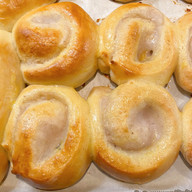This was a new one for me inspired by my little brother's best friend. According to Wikipedia, taro is a tropical plant grown primarily for its edible corms. It is a root vegetable but its leaves and stems are also edible and used in many cuisines. The root is nutritious full of good fiber, carbs, high in vitamin C, vitamin A and B6, potassium, magnesium, and iron. You can cook it up just like you would a potato - roast, mash, fry. Just make sure to peel the rough, thick skin off. It can go sweet or savory! Such a versatile vegetable!

I know it might seem strange to use taro in this form but trust me, it is delicious! It makes a smooth, creamy sweet filling for desserts. You can add a bit of food color if you like but I prefer to just go natural.
Taro Baos/Buns
Ingredients
Tangzhong
6 tablespoons whole milk
2 tablespoons unbleached bread flour
4 tablespoons unsalted butter, cut into small cubes
Dough
1 Tablespoon active dry yeast
4 Tablespoons sugar
2 Tablespoons warm water
1/2 cup whole milk
2 1/2 cups unbleached bread flour (or high performance bread flour - recommended)
1 teaspoon salt
1 large egg
Egg wash
1 egg, lightly beaten
1 Tablespoon water
1 Tablespoon honey
Garnish
2 Tablespoons sesame seeds
Filling
10 oz taro, peeled and cut up into 1" cubes
1/4 cup sugar (or more if you like it sweeter)
1/4 cup coconut milk
pinch of salt
Directions
Make the tangzhong: Combine milk and flour in a small saucepan and whisk until smooth. Place the saucepan over low heat, and cook the mixture, whisking constantly, until you get to a thick gravy consistency 3 to 5 minutes. Remove from heat. Add butter, stir until incorporated and set aside to cool.
Give the yeast a little head start. In a small bowl add the yeast, 1 tablespoon of sugar and 2 tablespoons of warm water. Let sit to start blooming while you get your other ingredients together.
Make the dough: Fit mixer with the paddle attachment. In the mixing bowl add milk, flour, remaining 3 tablespoons of sugar, salt, tangzhong, and yeast mixture and mix 1 minute. Switch to dough hook and knead 1 minute. Add egg and continue kneading for an additional 8 minutes or until a smooth, elastic dough forms. If kneading by hand mix with a silicone spatula first until you get a shaggy looking dough then switch to kneading by hand. Do not worry if it feels sticky at first. Keep kneading allowing flour to absorb moisture. If it is too dry add 1 tablespoon of water at a time. If it is too sticky, add 1 tablespoon of flour at a time. Dough should look smooth and feel like play dough.
Shape the dough into a ball, and let it rest in a lightly greased covered bowl for 60 to 90 minutes, until puffy but not necessarily doubled in bulk. Your "off" oven is a good place.
Make the filling: Place cubed taro in a saucepan and cover with water. Boil on medium high for about 20-25 minutes until it is soft. Reserve 1/2 cup of liquid then drain and add to a blender with the pinch of salt, sugar and coconut milk. Blend until smooth. If too thick, add a little bit of the reserved liquid 1 tablespoon at a time to reach desired consistency. It will thicken as it cools. Going for a thick paste consistency. Set aside to cool. If not using right away, cool then store in an airtight container in the refrigerator up to 5 days.
Gently deflate the dough. Roll out dough into a rectangle approximately 10"x12". Spread filling over the dough then roll up along the long side. Pinch edges closed then cut into 12 pieces. Place on a sheet tray lined with parchment or greased pan, cover lightly with a damp towel and let rest for 40 to 50 minutes, until puffy.
In a small bowl mix the egg, water and honey with a fork until honey is dissolved.
Preheat the oven to 350°F. Brush the rolls with egg wash. Bake for 15 minutes, and brush on some more egg wash. Bake for another 10-15 minutes, until golden brown on top; a digital thermometer inserted into the center of the middle bun should read at least 190°F.
Remove the buns from the oven. Allow them to cool in the pan for 10 minutes, then transfer them to a rack to cool completely.






















Comments